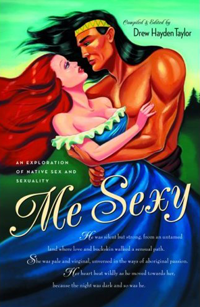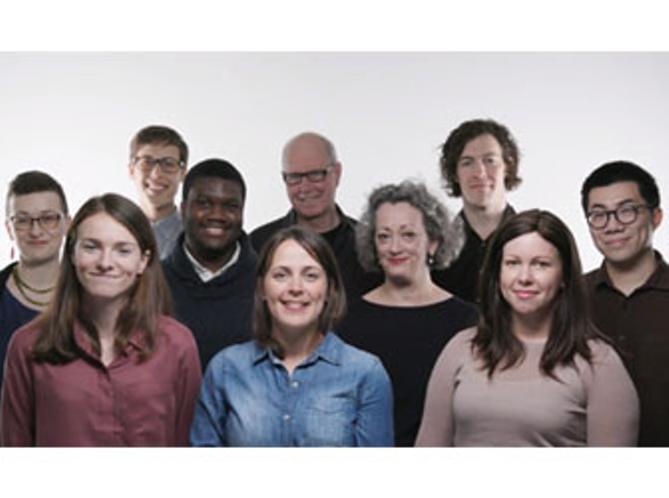
- Me Sexy: An Exploration of Native Sex and Sexuality
- Douglas & McIntyre (2008)
There is an old saying: "The older you get, the less sex you have, and the more you talk about it." If you'll pardon the pun, that makes older people oral experts on sex when it is a little late to be considered sexy.... This society is focused on projecting sexiness only through youth, but many of our elders don't buy into that idea much, and of course neither do I.
Falling in love and being sexy are not always tied together, but falling in love inspires us all to fall back on the sexy machinations of our youth. As long as sexual desire burns inside, we remain sexy and thus forever young. I had an opportunity to witness one of my elders fall in love in her 60s, and it struck me how much romance became her. Sexy seems to have more to do with desire and aliveness than anything else.
First Nations people, particularly 55+ women, are not billed as sexy anywhere by anyone; generally, coupling (pardon the pun) First Nations women with sex is done crudely when it is done at all. There are no First Nations supermodels or sexual icons out there, so procreative sex is spoken about without fanfare and with a certain measure of disregard for the femininity and the beauty of the women being referenced.
Don Burnstick is a comic who looks funny and makes funny faces, so when he says, "I saw a beautiful Ojibwa woman once" and makes a face, people laugh. When he follows it with, "It could happen," only half the audience laughs, because for some of us, this "joke" is not all that fun or funny.
Underlying his sense of humour is the disqualification of the sexiness of an entire nation of women. Salish humorists try very hard to poke fun at human folly without completely disqualifying humanity itself. We try to have fun with each other and not at each other's expense.
A hilarious thing to contemplate
Western society's values have always confused me. On the one hand, sexiness in young women is desired, but on the other hand, for a very long time the sexy woman engaging in sex was considered immoral.
"What good does it do to cajole and persuade a woman into having sex with you, then humiliate and berate her for it when she gives in?" this old chief asked some white guy a couple of hundred years ago. It seems that while women are burdened with the responsibility of being sexy, permission to engage in sex is generally considered a male prerogative, although that attitude is changing slowly.
So what is sexy? I have to say that the act itself seems hilarious to me, when I am not engaged in it. There is nothing we do that is so much fun but looks so ridiculous as when two people fumble around, roll around and then bounce up and down on each other, all the while uttering odd grunts and sighs. The prelude to sexual intercourse, though, is lovely.
When sexual desire is sparked up, no matter how old we are, our movements become elegant and smooth, determined, nearly urgent and sure, and our voices acquire that husky come-hither musicality that is so sweet. We feel our curves; our chests/breasts push themselves out almost with a will of their own.
Our hips sway, and our nipples perk up and become sensitive. We can feel the desire rising from our loins. Our skin tingles. Whatever stresses and worries we have on our minds slip away for the moment. We lean into the conversation of a prospective lover, soften our voices, twirl our fingers in our hair and bat our eyes. We giggle and laugh at jokes we wouldn't normally consider funny.
We reach out and sneak secret little touches, extend quick and secretive caresses in those forbidden places, move into our significant other, brushing nipples against his arm or his chest in feigned innocence, as though it were an accident. We imbue the world around us with sexual meaning, which gives birth to some good old sexually laden double-entendre:
"Coffee?" he purrs side-glancing, eyes intense with desire and full of some crazy kind of knowing where this is leading.
"Oh, yeah," I answer, lips swelling, thighs quivering; my mouth relaxes and pouts. I am careful not to completely close it. I am doubly careful to hold the pout. My tongue plays an old game of sneak up with my barely open mouth. He looks at me with lascivious intent, sucks wind and holds. Oh yeah, this is going where I want it to.
"Sugar?" He drawls as though he considered it my very essence, my name.
"Yesss..." I am very near to orgasm. Yup, this is where I want to be.
Choosing partners
In the modern world, men are expected to court women, but in the Salish world, this transformation is in its infancy. In the original Salish cultures, it was the women who chose the partners, and our women elders negotiated the marriage, if there was going to be one. If a woman desired a man and no marriage was in the offing for her, she was going to have an affair of the heart, because for sure, women were free to indulge in sexual activity when and if they pleased. Unlike in some other First Nations cultures, sex and morality were not that tightly connected (again, pardon the pun).
As a young person my chiefs asked me to organize the youth and encourage them to attend the first all chiefs' conference in Kamloops, B.C. So I called a youth gathering to be held at the local Indian Friendship Centre in Vancouver, notified all the young people I knew and made a presentation on behalf of the not-quite-fully-formed Union of B.C. Indian Chiefs.
It was 1968, the year the skimpy, sexy T-shirt came on the scene for young women. I was wearing one. Along with my skimpy T-shirt I had on a pretty snug pair of jeans and no bra (it was the 60s). An elder from Saskatchewan named Ernest Tatoosis came up after my talk and complimented my speech. After a pregnant pause he added, staring at my cleavage (small though it was), "But maybe you should dress more traditional," and he pointed at my shirt. I knew what he meant. He was well known for scolding women for wearing sexy clothing.
"Real Indian women wore dresses, long dresses, covering their legs and buttoned to the neck."
I suddenly remembered a picture of a group of First Nations men dressed in Western pants, shirts and sporting little mini-skirts and holding old rifles. Should I tell him that I will wear a long dress buttoned to the neck if he wears that mini-skirt? He probably wouldn't get it. "You're right," I answered instead, and I removed my shirt.
Cree women apparently wore long dresses (deerskin) before Europeans arrived, and traditionally covered their bodies pretty much head to toe. What Tatoosis did not know was that, prior to the arrival of the good Oblates, Salish women did not wear shirts during the summer or at a good old bone game.
Who gives permission, and why?
In this era of Aboriginal studies, there is a tendency to red-wash or clean up our past before passing on our traditions, and sometimes it gets cleaned up in accordance with someone else's current morality. I am not advocating a return to the old lahal games practices, in which women sang and danced half-naked, enthusiastically cupping and bouncing their beautiful breasts in an attempt to distract the other team, but we should know a little about who we are before we become someone else's idea of who we should be.
Sex, whether it is hetero- or homosexual, is so central to adult human interaction -- all adults at some point feels their loins fire up with desire, and sexiness is our response to it.
Sexual permission, however, is structured by the social milieu from which we arise. One time, a fellow wolf clan woman from the Six Nations told me she was going to visit my home. She is like many Six Nations women -- sexy, tall and with one of those lyrical, husky and luscious voices we all love to listen to.
"So, you are going to have fun with the little people," I said, adding that we were the "cutest people in the world."
She did. She returned and said that everyone there was short and thin and, exactly like I'd said, cute. Even the men, she added with a delicious laugh. She said they were so cute and so small, she wanted to put a couple of them in her coat pocket and take them home.
"The men would just come up to me and look at me, smiling. It was so funny, so odd. What was that all about?"
"They were making a pass," I said. "The smile is telling you, 'I'm available and willing.'"
"You mean all I had to do was grab one of them and take him home?"
"Pretty much," I said.
"No wonder West Coast women are so aggressive," she laughed.




